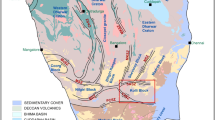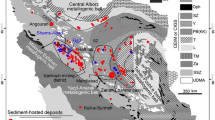Abstract
The ~2,752-Ma Weld Range greenstone belt in the Yilgarn Craton of Western Australia hosts several Fe ore deposits that provide insights into the role of early hypogene fluids in the formation of high-grade (>55 wt% Fe) magnetite-rich ore in banded iron formation (BIF). The 1.5-km-long Beebyn orebody comprises a series of steeply dipping, discontinuous, <50-m-thick lenses of magnetite–(martite)-rich ore zones in BIF that extend from surface to vertical depths of at least 250 m. The ore zones are enveloped by a 3-km-long, 150-m-wide outer halo of hypogene siderite and ferroan dolomite in BIF and mafic igneous country rocks. Ferroan chlorite characterises 20-m-wide proximal alteration zones in mafic country rocks. The magnetite-rich Beebyn orebody is primarily the product of hypogene fluids that circulated through reverse shear zones during the formation of an Archean isoclinal fold-and-thrust belt. Two discrete stages of hypogene fluid flow caused the pseudomorphic replacement of silica-rich bands in BIF by Stage 1 siderite and magnetite and later by Stage 2 ferroan dolomite. The resulting carbonate-altered BIF is markedly depleted in SiO2 and enriched in CaO, MgO, LOI, P2O5 and Fe2O3(total) compared with the least-altered BIF. Subsequent reactivation of these shear zones and circulation of hypogene fluids resulted in the leaching of existing hypogene carbonate minerals and the concentration of residual magnetite-rich bands. These Stage 3 magnetite-rich ore zones are depleted in SiO2 and enriched in K2O, CaO, MgO, P2O5 and Fe2O3(total) relative to the least-altered BIF. Proximal wall rock hypogene alteration zones in mafic igneous country rocks (up to 20 m from the BIF contact) are depleted in SiO2, CaO, Na2O, and K2O and are enriched in Fe2O3(total), MgO and P2O5 compared with distal zones. Recent supergene alteration affects all rocks within about 100 m below the present surface, disturbing hypogene mineral and the geochemical zonation patterns associated with magnetite-rich ore zones. The key vectors for identifying hypogene magnetite-rich Fe ore in weathered outcrop include textural changes in BIF (from thickly to thinly banded), crenulated bands and collapse breccias that indicate volume reduction. Useful indicators of hypogene ore in less weathered rocks include an outer carbonate–magnetite alteration halo in BIF and ferroan chlorite in mafic country rocks.




















Similar content being viewed by others
References
Angerer T, Hagemann SG (2010) The BIF-hosted high-grade iron ore deposits in the Archean Koolyanobbing greenstone belt, Western Australia: structural control on synorogenic- and weathering-related magnetite-, hematite-, and goethite-rich iron ore. Econ Geol 105:917–945
Cassidy KC, Champion DC, Krapez B, Barley ME, Brown SJA, Blewett RS, Groenewald PB, Tyler IM (2006) A revised geological framework for the Yilgarn Craton, Western Australia. Geological Survey of Western Australia, Perth, 8 pp
Clark AM (1993) Hey’s mineral index, mineral species, varieties and synonyms. Chapman and Hall, London
Dalstra H, Harding T, Riggs T, Taylor D (2003) Banded iron formation hosted high-grade hematite deposits, a coherent group? T I Min Metall B 112:B68–B72. doi:10.1179/037174503225011199
Dalstra H, Guedes ST (2004) Giant hydrothermal hematite deposits with Mg–Fe metasomatism: a comparison of the Carajas, Hamersley, and other iron ores. Econ Geol 99:1793–1800
Duuring P, Hagemann SG (2010) High-grade iron mineralisation at the Beebyn deposit, Weld Range, Western Australia. In: Tyler IM, Knox-Robinson CM (eds) 5th International Archean Symposium: abstracts. Geological Survey of Western Australia, Perth, pp 291–293
Duuring P, Hagemann SG (2012) Genesis of superimposed hypogene and supergene Fe orebodies in BIF at the Madoonga deposit, Yilgarn Craton, Western Australia. Miner Deposita. doi:10.1007/s00126-012-0429-0
Duuring P, Hagemann SG, Novikova J, Cudahy T, Laukamp C (2012) Targeting iron ore in banded iron formation using ASTER data: Weld Range greenstone belt, Yilgarn Craton, Western Australia. Econ Geol 107:585–597
Gole MJ (1980) Mineralogy and petrology of very-low-metamorphic grade Archaean banded iron-formations, Weld Range, Western Australia. Am Mineral 65:1–2
Grant JA (1986) The isocon diagram—a simple solution to Gresens’ equation for metasomatic alteration. Econ Geol 81:1976–1982
Hallimond AF (1925) Iron ores: bedded ores of England and Wales. Petrography and chemistry. Memoirs Geol Surv Great Britain (Spec Rep Miner Resour Great Britain) 29:111
Hutchison CS (1974) Laboratory handbook of petrographic techniques. Wiley, New York
Ivanic T (2009) Madoonga, WA Sheet 2444–1:100 000 geological series. Geological Survey of Western Australia, Perth
Ivanic TJ, Wingate MTD, Kirkland CL, Van Kranendonk MJ, Wyche S (2010) Age and significance of voluminous mafic–ultramafic magmatic events in the Murchison Domain, Yilgarn Craton. Aust J Earth Sci 57:597–614. doi:10.1080/08120099.2010.494765
Maskell A (2010) Multi-stage structural controls and hypogene alteration of high-grade Fe-mineralisation at Matthew Ridge prospect, Jack Hills greenstone belt, Yilgarn craton. Honours thesis, Faculty of Natural and Agricultural Sciences, The University of Western Australia, Perth, Australia, 50 pp
McClung CR (2006) Basin analysis of the Mesoproterozoic Bushmanland Group of the Namaqua metamorphic province, South Africa. PhD thesis, University of Johannesburg, Auckland Park, 307 pp
McDonough WF, Sun SS (1995) The composition of the Earth. Chem Geol 120:223–253
McLennan SM (1989) Rare earth elements in sedimentary rocks: influence of provenance and sedimentary processes. Rev Mineral Geochem 21:169–200
Oliver B (1999) Granitoids of the Mount Mulgine and Noongal Areas, Murchison Province, Western Australia: origin and relationship with granitophile and gold mineralisation. Honours thesis, The University of Western Australia, Perth, 98 pp
Spaggiari CV (2006) Interpreted bedrock geology of the northern Murchison Domain, Youanmi Terrane, Yilgarn Craton. Western Australian Geological Survey, Perth, 19 pp
Taylor D, Dalstra HJ, Harding AE, Broadbent GC, Barley ME (2001) Genesis of high-grade hematite orebodies of the Hamersley province, Western Australia. Econ Geol Bull Soc 96:837–873
Thorne W, Hagemann S, Webb A, Clout J (2008) Banded Iron Formation-related iron ore deposits of the Hamersley Province, Western Australia. Rev Econ Geol 15:197–221
Van Kranendonk MJ (2008) New evidence on the evolution of the Cue–Meekatharra area of the Murchison Domain, Yilgarn Craton. Geological Survey of Western Australia, Perth, pp 39–49
Van Kranendonk MJ, Ivanic TJ (2009) A new lithostratigraphic scheme for the northeastern Murchison Domain, Yilgarn Craton. Geological Survey of Western Australia, Perth, pp 35–53
Wang Q (1998) Geochronology of the granite–greenstone terranes in the Murchison and Southern Cross Provinces of the Yilgarn Craton, Western Australia thesis, Australian National University, Canberra, 173 pp
Yeats CJ, Mcnaughton NJ, Groves DI (1996) SHRIMP U–Pb geochronological constraints on the age of synvolcanic VHMS mineralisation and overprinting epigenetic lode-gold mineralisation at the Archaean Mount Gibson gold deposits, Yilgarn Craton, Western Australia. Econ Geol 91:1354–1371
Acknowledgments
This study was financially supported by Sinosteel Midwest Corporation. Peter Stockman and Denis Kruger, and a long list of Weld Range exploration and resource geologists, and field assistants, are thanked for their generous logistical support and for access to digital data. Chriss Schindler drafted Fig. 1, whereas Elizabeth Colgan and Seok-Jun Yang assisted with the polishing and imaging of hand specimens. The manuscript greatly benefited from comments received from Thomas Angerer and Tim Ivanic and official reviews by Jens Gutzmer, Roberto Xavier, Bernd Lehmann and an anonymous reviewer.
Author information
Authors and Affiliations
Corresponding author
Additional information
Editorial handling: R.P. Xavier
Electronic supplementary materials
Below is the link to the electronic supplementary material.
Online Resource 1
Whole-rock and trace element data for selected rocks at Beebyn (XLSX 91 kb)
Online Resource 2
Thin section photomicrographs of contact metamorphic aureoles in North BIF surrounding a basalt sill. a Distal area to the sill (1 m away): Fe oxide-rich bands in BIF contain agglomerates of irregularly shaped, fine- to coarse-grained magnetite. b Distal zone: Silica-rich bands contain fine-grained, disseminated hematite with patches of recrystallised metamorphic magnetite (now partly replaced by martite) and surrounded by recrystallised quartz. c Proximal zone in BIF located within 1 cm of a basaltic sill. Primary bands are preserved, but comprise coarse-grained, equant magnetite (martite) and quartz grains. d Proximal zone: Silica-rich bands contain metamorphic magnetite (martite) that are intergrown with recrystallised quartz. Thin section photomicrographs were taken in reflected plane-polarised light (a, c) and transmitted plane- (b) and cross-polarised light (d). Hem hematite, Mag magnetite, Mt martite, Qtz quartz (JPEG 169 kb)
Online Resource 3
Averaged whole-rock and trace element data for main rock types at Beebyn (XLSX 32 kb)
Online Resource 5
Rare earth element trends for mafic igneous country rocks surrounding the North BIF (normalised against the chondrite value of McDonough and Sun 1995) (JPEG 50 kb)
Rights and permissions
About this article
Cite this article
Duuring, P., Hagemann, S. Leaching of silica bands and concentration of magnetite in Archean BIF by hypogene fluids: Beebyn Fe ore deposit, Yilgarn Craton, Western Australia. Miner Deposita 48, 341–370 (2013). https://doi.org/10.1007/s00126-012-0428-1
Received:
Accepted:
Published:
Issue Date:
DOI: https://doi.org/10.1007/s00126-012-0428-1




